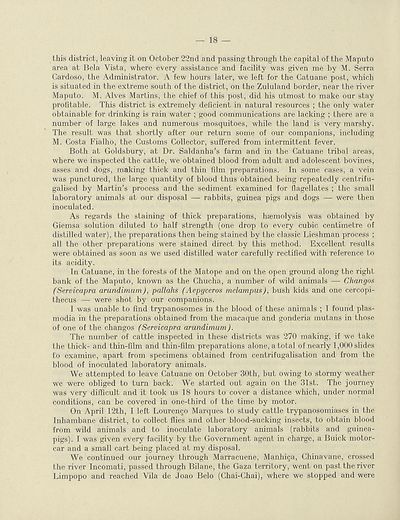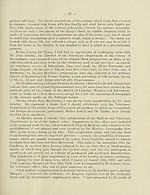Download files
Complete book:
Individual page:
Thumbnail gallery: Grid view | List view

— 18
this district, leaving it on October 22nd and passing through the capital of the Maputo
area at Bela Vista, where every assistance and facility was given me by M. Serra
Cardoso, the Administrator. A few hours later, we left for the Catuane post, which
is situated in the extreme south of the district, on the Zululand border, near the river
Maputo. M. Alves Martins, the chief of this post, did his utmost to make our stay
profitable. This district is extremely deficient in natural resources ; the only water
obtainable for drinking is rain water ; good communications are lacking ; there are a
number of large lakes and numerous mosquitoes, while the land is very marshy.
The result was that shortly after our return some of our companions, including
M. Costa Fialho, the Customs Collector, suffered from intermittent fever.
Both at Goldsbury, at Dr. Saldanha’s farm and in the Catuane tribal areas,
where we inspected the cattle, we obtained blood from adult and adolescent bovines,
asses and dogs, making thick and thin film preparations. In some cases, a vein
was punctured, the large quantity of blood thus obtained being repeatedly centrifu-
galised by Martin’s process and the sediment examined for flagellates ; the small
laboratory animals at our disposal — rabbits, guinea pigs and dogs — were then
inoculated.
As regards the staining of thick preparations, haemolysis was obtained by
Giemsa solution diluted to half strength (one drop to every cubic centimetre of
distilled water), the preparations then being stained by the classic Lieshman process ;
all the other preparations were stained direct by this method. Excellent results
were obtained as soon as we used distilled water carefully rectified with reference to
its acidity.
In Catuane, in the forests of the Matope and on the open ground along the right
bank of the Maputo, known as the Chucha, a number of wild animals — Changos
(Servicapra arundimwn), pallahs (Aepyceros melampus), bush kids and one cercopi-
thecus — were shot by our companions.
I was unable to find trypanosomes in the blood of these animals ; I found plas-
modia in the preparations obtained from the macaque and gonderia mutans in those
of one of the changos (Servicapra arundimum).
The number of cattle inspected in these districts was 270 making, if we take
the thick- and thin-film and thin-film preparations alone, a total of nearly 1,000 slides
to examine, apart from specimens obtained from centrifugalisation and from the
blood of inoculated laboratory animals.
We attempted to leave Catuane on October 30th, but owing to stormy weather
we were obliged to turn back. We started out again on the 31st. The journey
was very difficult and it took us 18 hours to cover a distance which, under normal
conditions, can be covered in one-third of the time by motor.
On April 12th, I left Lourengo Marques to study cattle trypanosomiases in the
Inhambane district, to collect flies and other blood-sucking insects, to obtain blood
from wild animals and to inoculate laboratory animals (rabbits and guinea-
pigs). I was given every facility by the Government agent in charge, a Buick motor¬
car and a small cart being placed at my disposal.
We continued our journey through Marracuene, Manhiga, Chinavane, crossed
the river Incomati, passed through Bilane, the Gaza territory, went on past the river
Limpopo and reached Vila de Joao Belo (Chai-Chai), where we stopped and were
this district, leaving it on October 22nd and passing through the capital of the Maputo
area at Bela Vista, where every assistance and facility was given me by M. Serra
Cardoso, the Administrator. A few hours later, we left for the Catuane post, which
is situated in the extreme south of the district, on the Zululand border, near the river
Maputo. M. Alves Martins, the chief of this post, did his utmost to make our stay
profitable. This district is extremely deficient in natural resources ; the only water
obtainable for drinking is rain water ; good communications are lacking ; there are a
number of large lakes and numerous mosquitoes, while the land is very marshy.
The result was that shortly after our return some of our companions, including
M. Costa Fialho, the Customs Collector, suffered from intermittent fever.
Both at Goldsbury, at Dr. Saldanha’s farm and in the Catuane tribal areas,
where we inspected the cattle, we obtained blood from adult and adolescent bovines,
asses and dogs, making thick and thin film preparations. In some cases, a vein
was punctured, the large quantity of blood thus obtained being repeatedly centrifu-
galised by Martin’s process and the sediment examined for flagellates ; the small
laboratory animals at our disposal — rabbits, guinea pigs and dogs — were then
inoculated.
As regards the staining of thick preparations, haemolysis was obtained by
Giemsa solution diluted to half strength (one drop to every cubic centimetre of
distilled water), the preparations then being stained by the classic Lieshman process ;
all the other preparations were stained direct by this method. Excellent results
were obtained as soon as we used distilled water carefully rectified with reference to
its acidity.
In Catuane, in the forests of the Matope and on the open ground along the right
bank of the Maputo, known as the Chucha, a number of wild animals — Changos
(Servicapra arundimwn), pallahs (Aepyceros melampus), bush kids and one cercopi-
thecus — were shot by our companions.
I was unable to find trypanosomes in the blood of these animals ; I found plas-
modia in the preparations obtained from the macaque and gonderia mutans in those
of one of the changos (Servicapra arundimum).
The number of cattle inspected in these districts was 270 making, if we take
the thick- and thin-film and thin-film preparations alone, a total of nearly 1,000 slides
to examine, apart from specimens obtained from centrifugalisation and from the
blood of inoculated laboratory animals.
We attempted to leave Catuane on October 30th, but owing to stormy weather
we were obliged to turn back. We started out again on the 31st. The journey
was very difficult and it took us 18 hours to cover a distance which, under normal
conditions, can be covered in one-third of the time by motor.
On April 12th, I left Lourengo Marques to study cattle trypanosomiases in the
Inhambane district, to collect flies and other blood-sucking insects, to obtain blood
from wild animals and to inoculate laboratory animals (rabbits and guinea-
pigs). I was given every facility by the Government agent in charge, a Buick motor¬
car and a small cart being placed at my disposal.
We continued our journey through Marracuene, Manhiga, Chinavane, crossed
the river Incomati, passed through Bilane, the Gaza territory, went on past the river
Limpopo and reached Vila de Joao Belo (Chai-Chai), where we stopped and were
Set display mode to:
![]() Universal Viewer |
Universal Viewer | ![]() Mirador |
Large image | Transcription
Mirador |
Large image | Transcription
Images and transcriptions on this page, including medium image downloads, may be used under the Creative Commons Attribution 4.0 International Licence unless otherwise stated. ![]()
| League of Nations > Health > Investigations on human trypanosomiasis in Mozambique > (20) |
|---|
| Permanent URL | https://digital.nls.uk/191818382 |
|---|
| Shelfmark | LN.III |
|---|---|
| Description | Over 1,200 documents from the non-political organs of the League of Nations that dealt with health, disarmament, economic and financial matters for the duration of the League (1919-1945). Also online are statistical bulletins, essential facts, and an overview of the League by the first Secretary General, Sir Eric Drummond. These items are part of the Official Publications collection at the National Library of Scotland. |
|---|---|
| Additional NLS resources: |
|

